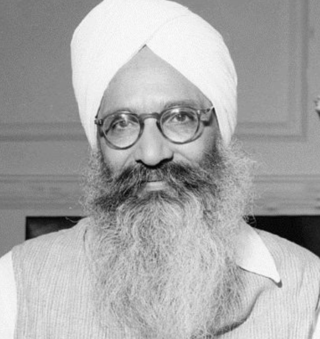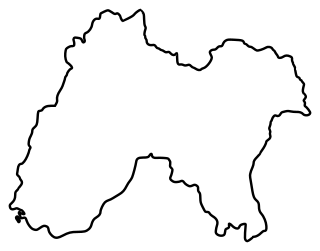Related Research Articles

The Punjabi Suba movement was a long-drawn political agitation, launched by the Sikhs, demanding the creation of a Punjabi Suba, or Punjabi-speaking state, in the post-independence Indian state of East Punjab. Led by the Akali Dal, it resulted in the formation of the state of Punjab. The state of Haryana and the Union Territory of Chandigarh were also created and some Pahari-majority parts of the East Punjab were also merged with Himachal Pradesh following the movement.

Partap Singh Kairon was the 3rd Chief Minister of the Punjab province, and is widely acknowledged as the architect of post-Independence Punjab Province. Moreover, he was an Indian independence movement leader. He was jailed twice by the British Empire, once for five years for organizing protests against British rule. His political influence and views are still considered to dominate politics in Punjab.
Politics in reorganised present-day Punjab is dominated by mainly three parties – Indian National Congress, Aam Aadmi Party and Shiromani Akali Dal (Badal). Since 1967, Chief Minister of Punjab has been predominantly from Jat Sikh community despite its 21 percent state population. Exceptions are Giani Zail Singh, the Chief Minister of Punjab from 17 March 1972 to 30 April 1977 belonging to Ramgarhia community that has population of 6 percent and is a part of significant OBC community having population of 31.3 percent in the state and Charanjit Singh Channi who held the position for 111 days from 20 September 2021 to 16 March 2022 and was from Scheduled Caste(Dalit) who have 32 percent population in the state. Other prominent party is Bahujan Samaj Party especially in Doaba region founded by Kanshi Ram of Rupnagar district. In 1992 BSP won 9 seats Vidhan Sabha elections. Also BSP won 3 lok sabha seats from Punjab in 1996 general elections and only Garhshanker seat in 1997 Vidhan Sabha elections. Communist parties too have some influence in the Malwa area. In the 2014 general elections, the first-time contesting Aam Aadmi Party got 4 out of 13 seats in Punjab by winning 34 of the total 117 assembly segments, coming second in 7, third in 73 and fourth in the rest 3 segments. The support for the Aam Aadmi Party increased later in Punjab. The current Government was elected in the 2022 Punjab Assembly elections and the AAP won 92 out of 117 Assembly seats with Bhagwant Mann as the Chief Minister. The Congress flows down to get only 18 seats.

Bhim Sen Sachar was an Indian politician who served three times as the Chief Minister of Punjab.

Adesh Pratap Singh Kairon is a politician from Punjab, India. He is a four-time Member of Legislative Assembly in the Punjab Legislative Assembly from the Patti Constituency. He has served thrice as a minister. He has held the portfolios of Excise and Taxation, Food and IT.

Parminder Singh Dhindsa is an Indian politician and belongs to the Shiromani Akali Dal (Sanyukt) Political Party. He was a member of the Shiromani Akali Dal until late 2019. He is currently MLA from Lehra and was leader of Shiromani Akali Dal Legislature group in Punjab Legislative Assembly until he quit. He was Minister for Finance & Planning (2012–2017) and Minister for Public Works (B&R) (2007–2012) in the previous Punjab Government. He is son of Rajya Sabha member Sukhdev Singh Dhindsa. He was first elected as MLA of Sunam in September 2000 by defeating Parmeshwari Devi of Congress during the by-election. He was re-elected as an MLA for the fifth consecutive term in 2017 with his tenure since 2000 to 2012 from Sunam and from 2017 onwards from Lehra Constituency. He is triumphant in his entire career since 2000.
Tripat Rajinder Singh Bajwa is an Indian politician and a member of Indian National Congress. He is a Member of Punjab Legislative Assembly (MLA) and represents Fatehgarh Churian. He heads the Ministries of Rural Development Now Animal Husbandry Panchayats and Water Supply & Sanitation for the Government of Punjab.
The Patiala and East Punjab States Union Legislative Assembly was the unicameral state-level legislative body of the Patiala and East Punjab States Union in India. Two elections to the assembly were held; one in 1951 and the second one in 1954. The assembly had 60 seats. The assembly used to meet at the Durbar (Court) of Qila Mubarak, the royal fort at Patiala.
Shanno Devi was an Indian politician was the first woman speaker of a State Assembly in India. She was member of the Indian National Congress from the state of Punjab. She was the speaker of the Haryana Legislative Assembly from 6 December 1966 to 17 March 1967, and the deputy speakers of the Punjab Legislative Assembly from 19 March 1962 to 31 October 1966.

Elections to the Punjab Provincial Assembly were held in January 1946 as part of the 1946 Indian provincial elections.

The 1952 Punjab Legislative Assembly election were the First Vidhan Sabha elections of the state when the Indian National Congress emerged as the largest party with 96 seats in the 126-seat legislature in the election. The Shiromani Akali Dal became the official opposition, holding 13 seats.

The 1957 Punjab Legislative Assembly election was the Second Vidhan Sabha election of the state when the Indian National Congress emerged as the largest party with 120 seats in the 154-seat legislature in the election. The Bharatiya Jana Sangh became the official opposition, holding 9 seats.
People's United Front was a Post Poll Alliance of 7 Political parties and Independents formed in a Convention at Khanna on 4 March 1967, in Punjab after the election of 1967.
The 1962 Punjab Legislative Assembly election was the Third Vidhan Sabha election of the state when the Indian National Congress emerged as the largest party with 90 seats in the 154-seat legislature in the election. The Shiromani Akali Dal became the official opposition, holding 16 seats. From 5 July 1966 to 1 November 1966, Assembly was under suspension.
The 1967 Punjab Legislative Assembly election was the Fourth Vidhan Sabha election of the state. This was the first hung assembly. Indian National Congress emerged as the largest party with 48 seats in the 104-seat legislature in the election. The Akali Dal - Sant Fateh Singh became the second, holding 24 seats. On 28 August 1968, Assembly dissolved prematurely and president rule was imposed.
The 1969 Punjab Legislative Assembly election was the fifth Vidhan Sabha election of the state. This was the second hung assembly. Shiromani Akali Dal emerged as the largest party with 43 seats in the 104-seat legislature in the election. The Indian National Congress became the second, holding 38 seats. On 13 June 1971, Assembly dissolved prematurely and president rule was imposed.
United Front was a Post Poll Alliance formed after the 1969 Punjab Legislative Assembly election by Akali Dal, Jan Sangh and Left Parties as no single party got absolute majority in Assembly.
The 1972 Punjab Legislative Assembly election was the sixth Vidhan Sabha election of the state. Indian National Congress emerged as the victorious party with 66 seats in the 104-seat legislature in the election. The Shiromani Akali Dal became the official opposition, holding 24 seats. On 30 April 1977, Assembly dissolved and president rule was imposed.
Rai Bahadur Ganga Saran was an Indian trade unionist and politician from Punjab. He was a member of the Punjab Provincial Assembly and both the Constituent Assembly of India and the Constituent Assembly of Pakistan.
References
- ↑ page xxviii-xxix of Punjab Vidhan Sabha Compendium . Retrieved on 12 January 2019.
- ↑ Turmoil in Punjab Politics by S. C. Arora. P. 27
- ↑ Turmoil in Punjab Politics by S. C. Arora. P. 27
- ↑ Turmoil in Punjab Politics by S. C. Arora. P. 30
- ↑ The Tribune, 4 April 1951.
- ↑ Congress factionalism gave life to article 356. 9 April 2016, Sunday Guardian Live. Retrieved 18 December 2021.
- ↑ Electoral politics in Punjab. (Pdf) P. 36-37. Retrieved 16 December 2021.